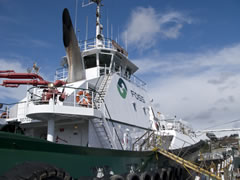Project Plan:
Martin Berg, an Associate Professor of Mechanical Engineering at the University of Washington, and Greg Mason, an Associate Professor of Mechanical Engineering at Seattle University, will collaborate on this project. In addition to their individual contributions, Professors Berg and Mason will jointly supervise a University of Washington graduate student whose efforts as a Research Assistant will be dedicated to the project.
| Task | Apr | May | Jun | Jul | Aug | Sep | Oct | Nov | Dec | Jan | Feb | Mar |
|---|---|---|---|---|---|---|---|---|---|---|---|---|
Select and install, in the pilothouse of the subject vessel, a personal computer (PC) with a suitable data acquisition card. |
•••• |
•••• |
||||||||||
Select and install, on the subject vessel, a fuel flow rate sensor for each engine and cabling from each such sensor to the PC in the pilot house. |
•••• |
•••• |
||||||||||
Select and install, on the subject vessel, an rpm sensor for each engine and cabling from each such sensor to the PC in the pilot house. |
•••• |
•••• |
||||||||||
Select and install, on the subject vessel, a GPS sensor and cabling from it to the PC in the pilot house. |
•••• |
•••• |
||||||||||
LabVIEW programming to enable the necessary communications between a LabVIEW application running on a PC and the fuel flow rate, rpm, and position (GPS) sensors. |
•••• |
•••• |
•••• |
|||||||||
Deploy an initial system to the PC in the pilothouse of the subject vessel. The capabilities of this system will be limited. They will include data collection and the display of basic information such as the current fuel efficiency (e.g., gallons per mile over land). |
•••• |
•••• |
||||||||||
Collect time, position, rpm, and fuel flow rate data, for the subject vessel, under representative operating conditions. |
•••• |
•••• |
•••• |
•••• |
||||||||
Develop a user interface for the pilothouse display, to include the superimposition of graphic elements on a background having a chart on which the route taken to the present time, and the proposed route to the destination, are displayed. |
•••• |
•••• |
•••• |
|||||||||
Research and develop the algorithm that will ultimately determine the information that will be displayed on the user interface in the pilothouse. |
•••• |
•••• |
•••• |
•••• |
•••• |
•••• |
•••• |
•••• |
||||
Program, in LabVIEW, the algorithm that will ultimately determine the information that will be displayed in the pilothouse. This task will include simulations utilizing the previously developed interfaces to the fuel flow rate, rpm, and position (GPS) sensors, and the previously collected time, position, rpm, and fuel flow rate data. |
•••• |
•••• |
•••• |
•••• |
•••• |
|||||||
Deploy all system components to the PC in the pilothouse of the subject vessel. |
•••• |
•••• |
||||||||||
Sea trials of the complete system in operation on the subject vessel. |
•••• |
•••• |
•••• |
Geoffery Hohn's MS Thesis: Computerized Fuel Management System for Foss Tugboat

